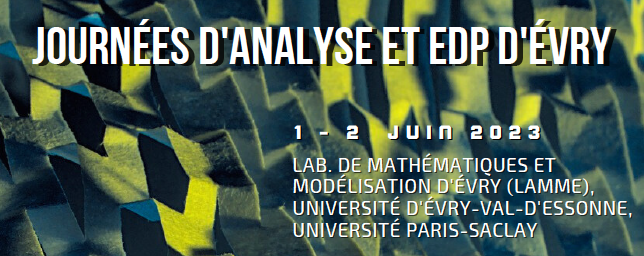
|
1-2 Jun 2023 - Salle A1 - Laboratoire de Mathématiques et Modélisation d'Évry, 23 Bd. de France, 91037 Évry Cedex (France)
|
TalksTitles and abstracts
Yvonne Alama-Bronsard (Sorbonne Université) Title. Résolution numérique d'équations dispersives à faible régularité. Abstract. On considérera dans cet exposé l'approximation d'équations dispersives pour des conditions initiales peu régulières, déterministes ou aléatoires.
Rana Badreddine (Université Paris-Saclay)
Title. The Calogero-Sutherland derivative nonlinear Schrödinger equation.
Abstract. We consider a type of nonlocal nonlinear Schrödinger equation with periodic boundary condition, called the Calogero-Sutherland DNLS equation.
We derive the explicit formula of the solution to this PDE. Moreover, using a Lax pair structure, we establish the global well-posedness of this equation in all the Hardy-Sobolev spaces $H^s_+(\mathbb{T})$, $s\geq 0$, under a mass assumption on the initial data for the focusing equation, and for arbitrary initial data for the defocusing equation.
Finally, a sketch of the proof for extending the flow to the critical regularity $L^2_+(\mathbb{T})$ will be presented.
Anne-Laure Dalibard (Sorbonne Université) Title. Nonlinear forward-backward problems »
Luigi De Rosa (University of Basel) Title. Dissipation regularity for irregular fluids motion. Abstract. It is well known that irregular fluids flows exhibit anomalous dissipation phenomena, a feature that has deep physical foundations. In several examples of main interest such dissipation is represented by a Radon measure. Assuming some integrability on the solution, in this talk I will describe how to derive a priori regularity results for the dissipation measure with respect to a reference Hausdorff. This naturally connects to intermittency, lower dimensional dissipations, energy conservation and singularity formation. The approach is rather geometrical and quite unifying, i.e. it directly applies to general conservation laws, providing sharp results in several situations. This builds on a recent work obtained in collaboration with Marco Inversi and Theodore D. Drivas.
Lucas Ertzbischoff (École polytechnique) Title. On thick spray equations Abstract. We consider a coupled system between kinetic and fluid equations, describing a cloud of particles immersed within a gas. In the "thick spray" regime, the volume fraction for the particles is not negligible compared to that of the fluid: this raises many difficulties for the study of such system, which seems to present several losses ofnderivatives. In particular, and contrary to some other fluid-kinetic couplings, its mathematical study has almost remained absent.
David Gérard-Varet (Université Paris Cité) Title. Phénomène de mélange en orientation pour des suspensions actives. Abstract. Nous décrirons un modèle cinétique popularisé par D. Saintillan et M. Shelley, qui décrit la dynamique de suspensions actives dans des fluides visqueux. Nous montrerons comment les propriétés de stabilité de ce modèle sont liées à un phénomène de mélange, similaire à l'amortissement Landau. L'originalité de l'étude vient de ce que la variable vitesse usuelle des modèles cinétiques est remplacée par une variable d'orientation sur la sphère. Cela crée des différences qualitatives et des difficultés mathématiques que nous tâcherons de présenter. L'exposé s'appuie sur un travail en collaboration avec M. Coti Zelati et H. Dietert.
Laura Kanzler (Université Paris Dauphine) Title. Boltzmann mean-field game model for knowledge growth. Abstract. Subject of this talk will be a Boltzmann mean field game (BMFG) model for knowledge growth, originally introduced by the economists Lucas and Moll [‘14]. In BMFG the evolution of the agent density with respect to their knowledge level is described by a Boltzmann-type equation. Agents increase their knowledge through binary interactions with others; their increase is modulated by the interaction and learning rate: Agents with similar knowledge learn more in encounters, while agents with very different levels benefit less from learning interactions. The optimal fraction of time spent on learning is calculated by a Bellman equation, resulting in a highly nonlinear forward-backward in
Sylvie Monniaux (Université Aix-Marseille) Title. Le système de Keller-Segel Navier-Stokes dans des domaines non réguliers. Abstract. On s’intéresse au système de Keller-Segel Navier-Stokes qui décrit une population de cellules soumises à un attractant chimique baignant dans un fluide en dimension 3, le tout dans un domaine lipschitzien. Les variables du système sont la densité de cellules, la concentration de l’attractant chimique et la vitesse du fluide. On peut déterminer les espaces critiques pour chacune de ces variables et on prouve l’existence de solutions dans ces espaces critiques. Les méthodes employées font appel à la régularité maximale à poids ainsi qu’aux résultats récents sur le système de Dirichlet-Stokes dans des domaines lipschitziens. Marjolaine Puel (Cergy Paris University) Title. Fractional diffusion approximation for Fokker Planck equation, a spectral method. Abstract. Since quiet a few years, kinetic equations describing particles are approached by macroscopic equations much more simple for numerical analysis. For example, particles, whose repartition satisfies a Fokker Planck equation with an equilibrium in velocities given by a Gaussian distribution, are well described by a density satisfying a heat equation. When the equilibrium decrease slower than a Gaussian, as a power, the macroscopic density satisfies a (non local) fractional diffusion equation. This result has been obtained by different methods the last two years. I will present a spectral method.
Frédéric Rousset (Université Paris-Saclay) Title. Interaction of a solitary water wave with a slowly varying bottom Abstract. In this talk we will discuss how a solution of the water wave system which behaves like a pure solitary wave in the past is influenced by a slowly varying monotonously increasing bottom. The main framework will be the water wave system with strong surface tension but we shall also use a Whitham type equation to illustrate the ideas. Joint work with Maria Eugenia Martinez (Lyon) and Claudio Munoz (Santiago)
|

